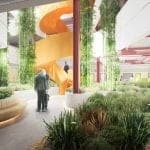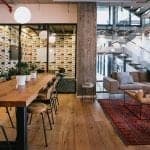Beyond the Wall . . . Inclusive and Convergent Design Considerations
Nowadays, creating an office space with the ‘wow’ factor isn’t the sole driver behind a refurbishment. The expectation to go much further than office aesthetics is evident globally. Spaces that empower employees, help businesses grow, support the working styles of a wide range of occupants, reflect company culture and harbour a green conscience are all seen as significant when designing spaces.
Here we delve deeper into inclusive and convergent considerations that are impacting on today’s office spaces and the people who work within them.
One for All, All for One . . . Inclusive design
At its heart, inclusive design aims to ensure things work for people – meeting the needs of as many individuals as possible.
Inclusive design considerations focus on creating spaces to suit not only employees with disabilities, but also those with different work preferences and different generations – Gen Y, Gen Z, baby boomers – and the likes of working parents. Think designed workplaces/cultures that accommodate people at different stages of their lives.
“These days a workforce can span generations and we need to cater to them,” says Kate Price of Outline Design. “We can support them in a design sense by looking at access, how different the working styles of varied generations can be – collaborative, private, relaxed, formal – even down to places for breastfeeding mothers or day-care options within larger companies.”
Take Google for example. A few years ago, they conducted interviews with nursing women to find out how best to support them when they returned from maternity leave and what they wanted for their mothers’ rooms. The result? Rooms designed to fit more than one mum at a time, but with curtained-off sections for privacy. All rooms have locks, curtains, desks, a comfortable chair, a foot rest, a refrigerator, cubbies, wipes, a stocked magazine rack, a hospital-grade Medela pump, a mirror, and a side table – some have sinks. Almost all have whiteboards or message boards so that mums can leave notes for each other and pin up photos of their babies – if they like! And they’re available 24/7.

Shirking Tradition . . . Convergent design
Employee satisfaction and workplace culture are intrinsically linked. Thus, creating an environment in which workers can flourish ultimately lends itself towards improving business success.
Prominent businessman and philanthropist, William Clement Stone once said, “You are a product of your environment. So, choose the environment that will best develop you toward your objective. Are the things around you helping you toward success – or are they holding you back?”
Today the traditional office space has broken free of the tired, grey and cold open-plan space of old. In fact, many spaces today can draw comparisons with cafes and other cultural places –something of a backlash against form follows function.

“There’s an idea that we use cafes as workspaces and workspaces as cafes – and there’s the possibility for design to reflect that culture,” says Kate. “Think spaces that incorporate a coffee bar, leaner, beanbags, break out rooms, music and video areas – and more. If we can chill at work, we will likely stay at work.”
Thus, by nurturing the very basic needs of your employees through comfortable work station set-ups, idea hubs, soft-seating areas and social spaces, businesses are ultimately keeping staff fulfilled. And when we’re happy in our jobs, the sky is the limit.
About Outline Design
Outline Design is an established commercial interior design firm based in Auckland, New Zealand offering the full range of interior design services. To find out more contact us.







